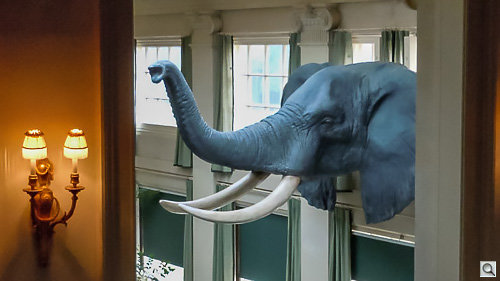Photo Corners headlinesarchivemikepasini.com
![]()
A S C R A P B O O K O F S O L U T I O N S F O R T H E P H O T O G R A P H E R
![]()
Enhancing the enjoyment of taking pictures with news that matters, features that entertain and images that delight. Published frequently.
Friday Slide Show: George Eastman House




24 June 2016
School is out, summer is simmering and our thoughts turn eastward even if our roller remains tucked in the closet this year. For almost 40 years we've been visiting Rochester, N.Y. And when we do, we almost always visit George Eastman House.
Eastman finished his work a long time ago. And what's left of his company only breaks your heart. It's work wasn't done but it ended its employment in much the same way. A self-inflicted wound.
Eastman House is much more than a house. It's an estate. The grounds themselves were, in his time, inspiringly named. The residence sat at one end of the lot (where it can still be found) with the Terrace Garden, Palm House, Cut Flower Garden and Rose Garden stretching out before it to the right and the West Garden, Peony Garden, Greenhouse, Poultry Yard, Cow Barn and Compost Yard to the left. Up the middle there was the Vegetable Garden, the Berries, the Rock Garden and the Vegetable Garden.
Landscape architect Alling S. DeForest laid all that out on the 10.5 acre property. As you can tell by the names, it was both a working farm and private garden. Ornamentals grew beside orchards and vegetables. Cows and chickens called the place home.
Today the formal Terrace Garden most resembles what it was in Eastman's time. The working farm and many of the gardens are gone, superceded by the George Eastman Museum. In fact, it's no longer even called George Eastman House but George Eastman Museum.
'What we do in our leisure hours determines what we are.'
And no wonder. Now the house looks out not on the gardens of an estate but a the Dryden Theater, a store and cafe, the Curtis Theater and a couple of galleries and a library. But they are what keep us coming back in what has been a lifelong education in photography.
These images were taken on June 27, 2010 with a Nikon Coolpix S8000 we were reviewing. They have the distinct advantage of having been processed this morning in Lightroom CC 2015.6. Or we would be embarrassed to show them to you.
We used the Upright tool on these interior shots of Eastman's home to straighten the verticals. We also used both Luminance and Color Noise Reduction to reign in the higher ISO shots (ISO 1250 was a disaster for noise). And for once, we had to tone down the Clarity. The image just started falling apart at the levels we usually use.
But usually we are working with DNG Raw files not the JPEGs the Nikon captured.
Still, we think these images give you a sense of how Eastman lived. You see his elephant trophy from one of his safaris overlooking the room where the organ would play every morning while he had his orange juice with his mother, who lived there, too.
A nice way to start the day.
Music was very important to him. He founded the Eastman School of Music, among his many other accomplishments. And we happened to walk by a stack of roll music for his player piano, the MP3 device of its day.
His downstairs library was a comfortable, book-lined room meant for recreation. His office, where he took his life in 1932, is upstairs.
Nothing is too much, not even the formal dining room where you can see the place set for his dear friend Josephine Dickman, whom he became particular close to after the death of his mother. And innovations, like electric lighting, were enthusiastically adopted.
We can recommend Elizabeth Brayer's biography of Eastman, George Eastman, A Biography, if you'd like to know more about the man.
He is famous for Kodak's tag line, "You push the button, we do the rest." But the line that haunts you as you walk through his home is something else. "What we do during our working hours determines what we have; what we do in our leisure hours determines what we are."
